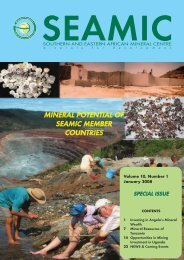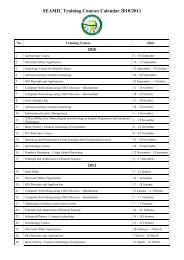SOUTHERN AND EASTERN AFRICAN MINERAL CENTRE - SEAMIC
SOUTHERN AND EASTERN AFRICAN MINERAL CENTRE - SEAMIC
SOUTHERN AND EASTERN AFRICAN MINERAL CENTRE - SEAMIC
Create successful ePaper yourself
Turn your PDF publications into a flip-book with our unique Google optimized e-Paper software.
Kaolin<br />
Kaolin is mined by EMD Share Company at Bombawha in Southern Ethiopia, about 430 km<br />
from Addis Abeba. This Kaolin is a product of in situ weathering of pegmatites and granites.<br />
The upper parts of the pegmatites and granites have been kaolinzed to a depth of 20mt. Proven<br />
reserves of 150,000 ton of kaolin had been identified in 1992, at which time open-pit mining<br />
operations began. The main consumers of its products are the Tabor Ceramics and Aluminum<br />
Sulphate Industries. The quality of the product satisfies its customers with an average Fe 2O 3<br />
content of 0.7 - 0.8%. The grade of Kaolin is 32 - 36% with a recovery of 96%. The final product<br />
has a grain size of less than 45 micrometer.<br />
Dolomite<br />
The Kenticha dolomite marble occurs north-west of the tantalum mine and extends for several<br />
kilometers in a north-south direction. The composition of the marble varies from calcite to<br />
magnesite and the grain size varies from fine to coarse. The Ethiopia Mineral Development<br />
Share Company sells its products to Modern Building Industry (MBI), a Saudi enterprise, after<br />
reducing its size to 0.1-0.3 mm by crushing. The final product is used as filler in paint, paper,<br />
and rubber industries and marketed locally and abroad. The annual production is 5,000 tons<br />
and the resource is about 1.5 million tons.<br />
Quartz and Feldspar<br />
Quartz and feldspar at Kenticha are mined as by-products of tantalum mining to be used for<br />
different applications. These industrial mineral products are consumed mainly by Tabor<br />
Ceramic Factory. The annual production is about 6,000 ton from a combined resource of one<br />
million tons.<br />
Soda Ash<br />
The Soda Ash Mine is located at Lake Abiyata in the Rift valley, about 200 km from Addis<br />
Ababa. The resource at Lake Abiyata and the neighboring lakes of Shalla and Chitu exceed<br />
460 mt of sodium carbonate at salt concentrations ranging from 1.1 to 1.9%. The plant produces<br />
about 20,000 ton/year of Soda Ash using solar evaporation harvesting system on a semiindustrial<br />
scale. The products are consumed by Caustic Soda, soap and detergent manufacturers<br />
as well as by water supply institutions.<br />
Opal<br />
Mining for opal has been going on since 1998 after exploration commenced in 1994 in the central<br />
part of the country by the private sector. Systematic exploration is underway to define bigger<br />
deposits and to look for better quality gems.<br />
Dimension Stones<br />
According to the US Geological Survey mining statistics, the production of dimension-stone<br />
in Ethiopia reached 100,000 tons in 1999 – an increase by 150% from 1995. This includes the<br />
production of granite, marble and limestone. The large increase in production was boosted by<br />
strong construction activity in the country. At present, there are several producing local and<br />
foreign private companies in Ethiopia. The National Mining Corporation (NMC), Saba<br />
Stones and Ethiopian Mining Industry (EMI) are mining marble, granite, and amphibolite and<br />
limestone in various part of the country. In addition to the local market, some of them are<br />
exporting the marble blocks to the Middle East and Europe.<br />
4<br />
Geological Survey of Ethiopia<br />
P.O.Box 2302, Addis Ababa, Ethiopia<br />
E-mail: geology.institute@ethionet.et<br />
Website:- www.geology.gov.et




